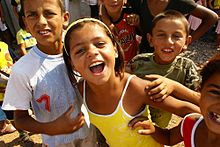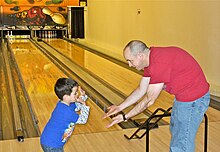User:Kelly0327/sandbox
{{multiple issues|globalize=September 2008|prose=September 2008}} Youth mentoring is the process of matching mentors with young people who need or want a caring, responsible adult in their lives. Adult mentors are usually unrelated to the child or teen and work as volunteers through a community-, school-, or church-based social service program. The goal of youth mentoring programs is to improve the well-being of the child by providing a role model that can support the child academically, socially or personally. This goal can be accomplished through school work, communication, or activities. Goals and settings within a mentoring program vary by country because of cultural values.[1]
Although informal mentoring relationships exist, formal, high-quality mentoring matches made through local or state mentoring organizations are often the most effective.
According to the encyclopedia of informal education:
"The classic definition of mentoring is of an older experienced guide who is acceptable to the young person and who can help ease the transition to adulthood by a mix of support and challenge. In this sense it is a developmental relationship in which the young person is inducted into the world of adulthood."[2]
Methods[edit]
School-Based[edit]
One prevalent method is referred to as the "School-Based" approach. The mentor meets with the youth in an academic setting and facilitates school work while acting as a supportive role-model.They may also play games, do crafts or partake in non-academic activities.[3]This approach is practiced organizations such as Big Brothers Big Sisters which is located in eleven countries including Ireland, the United States, Israel, and Bulgaria. As of 2005, there was an estimated 870,000 adults mentoring youth in a school-based program throughout The United States alone. [4]
Community Based[edit]
"Community Based" is another approach to mentoring.[5] In this setting, a mentor meets youth in the community such as a church, community facility, or by taking the child to community events. Both approaches can be done in a one-on-one or group setting. Individual vs. community based mentoring may be culturally specific, such as in India where youth are less in need of individual attention and thrive in a group setting, according to The International Journal of Social Work.[6]
Individual[edit]
Individual mentoring, or a one on one setting is where there is one mentor who repeatedly meets with the same mentee for the duration of their program. These partnerships can be found in both community and school-based One on one mentoring is seen in programs such as Big Brothers, Big Sisters in The United States, as well as Mentor Me India in India. Individual mentor relationships or mixed with some group meetings were found to be more effective than solely group mentoring, found in a study in The New Zealand Journal of Psychology.[7]
Group[edit]
Small group mentoring can be beneficial in places where there is a shortage of mentors, or youth are able to learn collectively in a group setting. This works with career oriented mentoring, when the focus is to encourage future success of the individual by bringing in successful professionals as mentors. This has found to be a successful approach in The Roma Mentor Project throughout Europe; it is able to build self confidence, and social skills while also teaching the importance of Roma culture. [8]
Mentoring Programs By Country[edit]
Youth mentoring takes place around the world, and countries take varying approaches to the concept based off values and needs of that country's youth. There are organizations such as Big Brothers, Big Sisters that have locations worldwide, as well as country specific organizations, such as Mentor Me India.
Hungary[edit]

The Romani population is about 1.9% of the total population in Hungary, according to the 2001 census.[9] There are 12 Million Romani across Europe, and they account for one of Europe's most vulnerable populations. Within the Romani population, there is a lack of education amongst youth accompanied by large numbers of illiteracy. Because of this trend, there was the creation of The Roma Mentor Project, which provides successful Romani adults to be role models of Romani youth. The program started in 2006, and by 2011, it spread to four other European countries with 1,400 participants. The program matches professionals in many different fields, such as government officials, professors, musicians, and media figures.These adults meets with groups of youth for two to three hours, twice a month, to influence their future decisions on education and career development. Already the program has found a shift in attitudes toward education and improvement in grades.[10]
India[edit]

Mentoring programs in the south of India have begun to rise in rural settings. Mentoring in India can be found in both a one-to-one setting as well as group settings. Mentor Me India is a specific program within urban India and is a program that executes small group mentoring within the community. These mentorships have a focus on girls aged 9 to 12, providing them female professionals as well as former menthes as mentors.[11] Another mentoring program that is starting in rural India implemented by United States researches as well as Indian community members. The purpose was to help with the impoverished youth who do not have access to the same resources as youth in an urban setting. When creating the program, Indian cultural norms and limited resource access were taken into account. The focus of this mentorship program is to develop leadership, academic achievement, and spiritual development while having a community service portion among the youth.[12]According to The Journal of International Social Work, one-on-one mentorships are not as fitting in rural India as they be elsewhere due to a lack of mentors as well as the desire to building peer relationships.[13]
South Africa[edit]

Starting in the 90's, after high rates of youth incarceration due to apartheid, non-governmental agencies decided there was need to advocate for the youth. The purpose of these organizations is to have an alternative to the formal justice setting, which kept around 30,000 youth per year out of criminal trial. One of the programs, Diversion into Music Education (DIME), has incorporated a mentor base approach through music appreciation. The program does not require any previous music capabilities and focuses on the student, not on the performance. The program is also located in Tampa, Florida, United States and allows for an intercultural exchange of staff members and video between organizations. The mentors role in this organization is to help youth set and achieve goals and assist in personal growth of the individual. Results from the program have showed positive outcomes on family relationships. [14]
The United States[edit]

The largest mentoring program in The United States is Big Brothers Big Sisters, this program is for youth from ages 6-18. The organization implements both community based as well as school based mentoring, and is typically a one-on-one mentorship. [15]There are also programs that are for specific groups of youth such as The National CARES Mentoring Movement, which was created in the aftermath of Hurricane Katrina. The program is provide strong black leaders to lead the black youth to a better future. At the start of the program 86 percent of black fourth graders were reading below grade level, and 1,000 black children a day are being arrested.[16] After joining the mentoring movement, 98 percent of participants stayed in school as well as avoided gang activity, and teen pregnancy. While 85 percent of youth in the program did not use drugs. Since starting in 2005, the program has since influenced over 125,000 lives of black youth. The mentoring typically takes place in the community in a group setting to create positive relations amongst the youth.[17] In 2002, the Institute of Medicine of the National Academy of Sciences published a major report examining after-school and other community programs designed to foster positive youth development. The report concluded that very few after-school programs “have received the kind of comprehensive experimental evaluation necessary to make a firm recommendation about replicating the program in its entirety across the country.” However, the report singled out mentoring programs modeled after the Big Brothers Big Sisters mentoring program as a rare exception, and recommended its widespread replication.[18]
See also[edit]
- Mentorship
- Youth club
- Peer mentoring
- Tutor
- StudentMentor.org
- Big Brothers Big Sisters of America
- MENTOR
- The Mentoring Project
- National Mentoring Month
References[edit]
- ^ Herrera, Carla (2011). "Mentoring in Schools: An Impact Study of Big Brothers Big Sisters School Based Mentoring". Child Development. 82 (1): 346–361. doi:10.1111/j.1467-8624.2010.01559.x. PMID 21291446.
{{cite journal}}: Unknown parameter|DUPLICATE_pages=ignored (help); Unknown parameter|coauthors=ignored (|author=suggested) (help); Unknown parameter|month=ignored (help) - ^ Philip, Kate (August 2000). "mentoring and young people". the encyclopedia of informal education. infed. Retrieved 2005-11-16.
{{cite encyclopedia}}: CS1 maint: date and year (link) - ^ Herrera, Carla (2011). "Mentoring in Schools: An Impact Study of Big Brothers Big Sisters School Based Mentoring". Child Development. 82 (1): 346–361. doi:10.1111/j.1467-8624.2010.01559.x. PMID 21291446.
{{cite journal}}: Unknown parameter|DUPLICATE_pages=ignored (help); Unknown parameter|coauthors=ignored (|author=suggested) (help); Unknown parameter|month=ignored (help) - ^ Herrera, Carla (2011). "Mentoring in Schools: An Impact Study of Big Brothers Big Sisters School Based Mentoring". Child Development. 82 (1): 346–361. doi:10.1111/j.1467-8624.2010.01559.x. PMID 21291446.
{{cite journal}}: Unknown parameter|DUPLICATE_pages=ignored (help); Unknown parameter|coauthors=ignored (|author=suggested) (help); Unknown parameter|month=ignored (help) - ^ Pryce, Julia (8). "The Development of a Youth Mentoring Program in the South of India". International Social Work. 54 (51): 12. doi:10.1177 (inactive 2023-08-02).
{{cite journal}}: Check|doi=value (help); Check date values in:|date=and|year=/|date=mismatch (help); Unknown parameter|DUPLICATE_pages=ignored (help); Unknown parameter|coauthors=ignored (|author=suggested) (help); Unknown parameter|month=ignored (help)CS1 maint: DOI inactive as of August 2023 (link) - ^ Pryce, Julia (8). "The Development of a Youth Mentoring Program in the South of India". International Social Work. 54 (51): 12. doi:10.1177 (inactive 2023-08-02).
{{cite journal}}: Check|doi=value (help); Check date values in:|date=and|year=/|date=mismatch (help); Unknown parameter|DUPLICATE_pages=ignored (help); Unknown parameter|coauthors=ignored (|author=suggested) (help); Unknown parameter|month=ignored (help)CS1 maint: DOI inactive as of August 2023 (link) - ^ Farruggia, Susan (2011). "The Effectiveness of Youth Mentoring Programmes in New Zealand". New Zealand Journal of Psychology. 40 (3): 70.
{{cite journal}}: Unknown parameter|DUPLICATE_pages=ignored (help); Unknown parameter|coauthors=ignored (|author=suggested) (help) - ^ Gruber, Andrea (Fall 2012). "Reclaiming Roma Students in Hungary". Reclaiming Children and Youth. 21 (3): 36.
{{cite journal}}: Unknown parameter|DUPLICATE_pages=ignored (help)CS1 maint: date and year (link) - ^ Central Intelligence Agency. "Hungary". Cia.Gov. Retrieved 19 October 2013.
- ^ Gruber, Andrea (Fall 2012). "Reclaiming Roma Students in Hungary". Reclaiming Youth International. 21 (3): 36. Retrieved 19 October 2013.
{{cite journal}}: Unknown parameter|DUPLICATE_pages=ignored (help)CS1 maint: date and year (link) - ^ "Mentor Me India". Retrieved 12 November 2013.
- ^ Pryce, Julia; Niederkorn, Alison; Goins, Margaret; Reiland, Melissa (10). "The Development of a Youth Mentoring Program in the South of India". International Social Work. 54 (1): 51–65. doi:10.1177/0020872810372559.
{{cite journal}}: Check date values in:|date=and|year=/|date=mismatch (help); Unknown parameter|DUPLICATE_pages=ignored (help); Unknown parameter|month=ignored (help) - ^ Pryce, Julia; Niederkorn, Alison; Goins, Margaret; Reiland, Melissa (10). "The Development of a Youth Mentoring Program in the South of India". International Social Work. 54 (1): 51–65. doi:10.1177/0020872810372559.
{{cite journal}}: Check date values in:|date=and|year=/|date=mismatch (help); Unknown parameter|DUPLICATE_pages=ignored (help); Unknown parameter|month=ignored (help) - ^ Woodward, Sheila (2008). "South Africa, The Arts and Youth in Conflict with the Law". Internation Journal of Community Music. 1 (1): 88. doi:10.1386 (inactive 2023-08-02). Retrieved 19 October 2013.
{{cite journal}}: Check|doi=value (help); Unknown parameter|DUPLICATE_pages=ignored (help); Unknown parameter|coauthors=ignored (|author=suggested) (help)CS1 maint: DOI inactive as of August 2023 (link) - ^ Herrera, Carla (2011). "Mentoring in Schools: An Impact Study of Big Brothers Big Sisters School Based Mentoring". Child Development. 82 (1): 346–361. doi:10.1111/j.1467-8624.2010.01559.x. PMID 21291446.
{{cite journal}}: Unknown parameter|DUPLICATE_pages=ignored (help); Unknown parameter|coauthors=ignored (|author=suggested) (help); Unknown parameter|month=ignored (help) - ^ Mitchell, Martin (Spring 2013). "National CARES Mentoring Movement". Reclaiming Children and Youth. 22 (1): 34.
{{cite journal}}: Unknown parameter|DUPLICATE_pages=ignored (help)CS1 maint: date and year (link) - ^ Mitchell, Martin (Spring 2013). "National CARES Mentoring Movement". Reclaiming Children and Youth. 22 (1): 34.
{{cite journal}}: Unknown parameter|DUPLICATE_pages=ignored (help)CS1 maint: date and year (link) - ^ "Community Programs to Promote Youth Development, p. 307". The National Academies Press. 2002.

